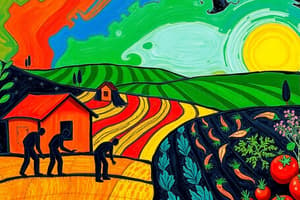Podcast
Questions and Answers
What significant climatic event set the stage for the Agricultural Revolution around 10,000 years ago?
What significant climatic event set the stage for the Agricultural Revolution around 10,000 years ago?
The warming of the climate from an Ice Age.
How did the surplus of food produced during the Agricultural Revolution affect human society?
How did the surplus of food produced during the Agricultural Revolution affect human society?
It allowed part of the population to specialize in non-food producing activities.
What role did enhanced irrigation systems and metallurgy play in the post-Agricultural Revolution era?
What role did enhanced irrigation systems and metallurgy play in the post-Agricultural Revolution era?
They improved agricultural efficiency and tool-making capabilities.
In what geographical regions did the first civilizations typically emerge after the Agricultural Revolution?
In what geographical regions did the first civilizations typically emerge after the Agricultural Revolution?
Describe the social impact of the Agricultural Revolution in terms of class divisions.
Describe the social impact of the Agricultural Revolution in terms of class divisions.
How did the development of government arise from the changes brought about by the Agricultural Revolution?
How did the development of government arise from the changes brought about by the Agricultural Revolution?
What were some non-food-producing occupations that emerged as a result of the Agricultural Revolution?
What were some non-food-producing occupations that emerged as a result of the Agricultural Revolution?
What was the role of writing in the context of post-Agricultural Revolution societies?
What was the role of writing in the context of post-Agricultural Revolution societies?
What was the significance of cuneiform in Sumerian society?
What was the significance of cuneiform in Sumerian society?
How did the structure of governance differ between Egypt and Sumer?
How did the structure of governance differ between Egypt and Sumer?
What architectural achievements are attributed to both Sumer and Egypt, and what purpose did they serve?
What architectural achievements are attributed to both Sumer and Egypt, and what purpose did they serve?
In what way did the rights of women in ancient Egypt differ from those in Sumer?
In what way did the rights of women in ancient Egypt differ from those in Sumer?
What is one of the unique cultural practices of the civilization that developed along the Huang He River?
What is one of the unique cultural practices of the civilization that developed along the Huang He River?
What challenges do historians face in understanding the Indus Valley Civilization?
What challenges do historians face in understanding the Indus Valley Civilization?
How did long-distance trade impact the city-states of Sumer and the Indus Valley Civilization?
How did long-distance trade impact the city-states of Sumer and the Indus Valley Civilization?
What was one key difference between the religious beliefs of the Sumerians and those of other ancient civilizations mentioned?
What was one key difference between the religious beliefs of the Sumerians and those of other ancient civilizations mentioned?
Flashcards are hidden until you start studying
Study Notes
Agricultural Revolution
- Occurred around 10,000 years ago, approximately 8000 B.C.E., as the climate warmed after an Ice Age.
- Initiated in the Middle East and marked the transition to farming and animal husbandry, resulting in food surpluses.
- Enabled certain populations to specialize in non-food producing roles, leading to innovations and societal changes.
Impact on Society
- Population growth facilitated larger settlements, which eventually evolved into cities.
- Emergence of specialized occupations, such as artisans (tool and weapon makers), merchants (traders), and priests (ritual leaders).
- Advancements in technology included improved irrigation systems, the invention of the wheel for transport, and the use of metals like bronze and iron for tools.
- Formation of more extensive governments to maintain order and manage resources, along with the establishment of taxation systems.
- Development of writing as a vital record-keeping tool for trade and taxation, which helped mitigate conflicts and manage societies.
Social Stratification
- Increased wealth accumulation led to distinct social classes defined by wealth and occupation, with notable declines in women's status in most civilizations.
First Civilizations
- Civilizations arose following the Agricultural Revolution, primarily in fertile river valleys where freshwater resources supported large populations.
Mesopotamia
- Recognized as the world's first civilization, situated between the Tigris and Euphrates rivers in modern-day Iraq.
- Characterized by city-states—independent cities that exerted control over surrounding territories, all operated under patriarchal systems.
- Known for monumental architecture (ziggurats) and engaging in long-distance trade with polytheistic beliefs.
- Sumer, a prominent city-state, introduced cuneiform, the first writing system, for documenting laws and trade.
Egypt
- Flourished in the Nile River valley with a centralized government led by a pharaoh.
- Developed hieroglyphics as their writing system and advanced mathematics.
- Constructed iconic monumental structures (pyramids) reflecting pharaohs' power.
- Women in Egypt had legal rights to own property and were considered equal to men in court, granting them higher social status than in most patriarchal societies.
Indus Valley
- Home to sophisticated civilizations like Harappa and Mohenjo-Daro, noted for their urban planning and technology, including indoor plumbing.
- Engaged in extensive trade with Mesopotamia and practiced polytheism.
- Language remains undeciphered, limiting knowledge about their culture compared to others.
China
- Developed a centralized and patriarchal system along the Huang He River, with a strong emphasis on ancestor veneration.
Non-River Valley Civilizations
- The Olmec in Mesoamerica and the Chavin in the Andes developed as complex societies, engaging in extensive trade without reliance on river valleys.
Religious Developments
- Meanwhile, the growth of cities coincided with the formation of new belief systems, such as Hinduism and Judaism.
Studying That Suits You
Use AI to generate personalized quizzes and flashcards to suit your learning preferences.



